tires Lexus ES350 2012 Owner's Manual
[x] Cancel search | Manufacturer: LEXUS, Model Year: 2012, Model line: ES350, Model: Lexus ES350 2012Pages: 554, PDF Size: 6.43 MB
Page 6 of 554
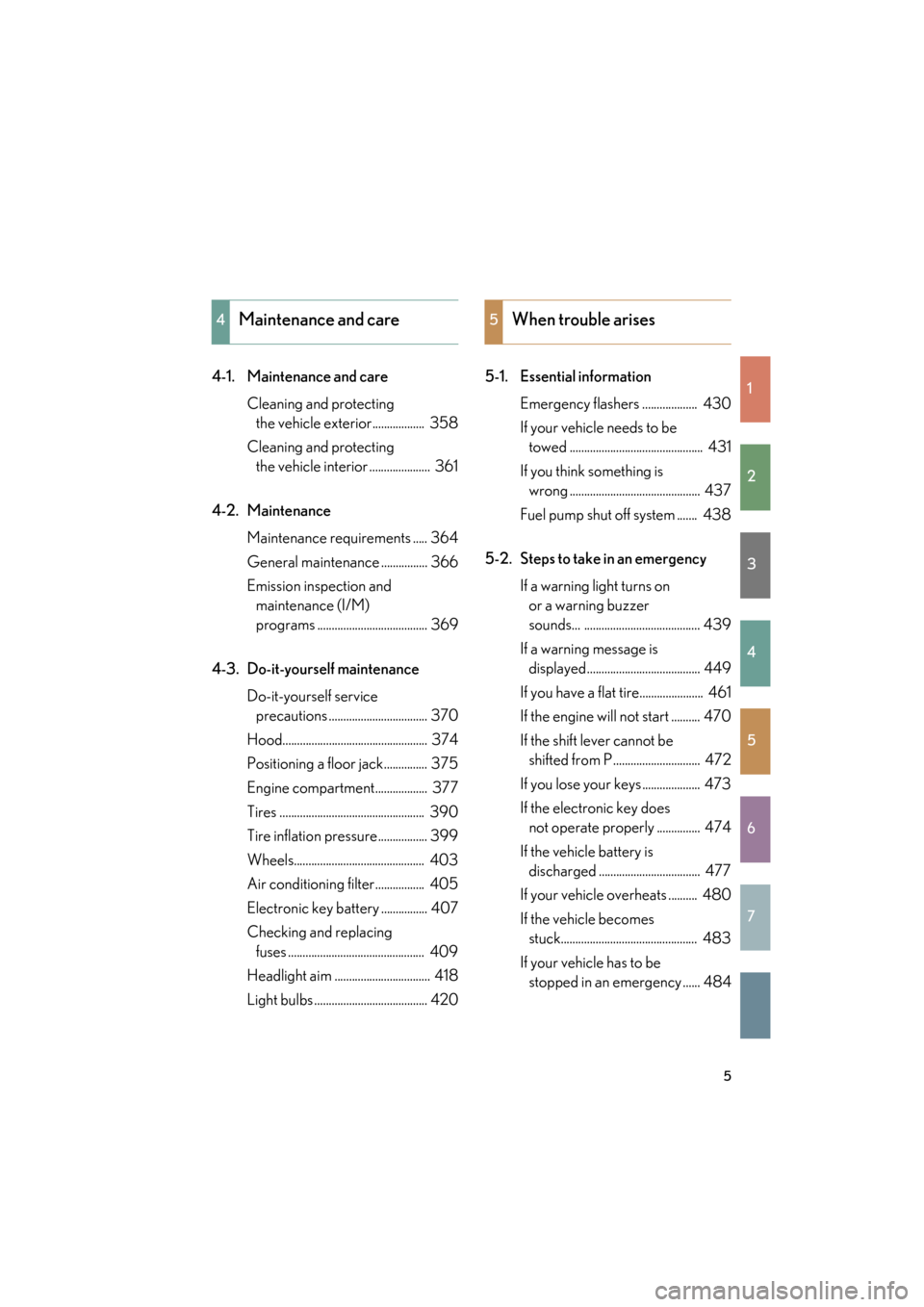
1
2
3
4
5
6
7
5
ES350_U
4-1. Maintenance and careCleaning and protecting the vehicle exterior.................. 358
Cleaning and protecting the vehicle interior ..................... 361
4-2. Maintenance Maintenance requirements ..... 364
General maintenance ................ 366
Emission inspection and maintenance (I/M)
programs ...................................... 369
4-3. Do-it-yourself maintenance Do-it-yourself service precautions .................................. 370
Hood.................................................. 374
Positioning a floor jack............... 375
Engine compartment.................. 377
Tires .................................................. 390
Tire inflation pressure................. 399
Wheels............................................. 403
Air conditioning filter................. 405
Electronic key battery ................ 407
Checking and replacing fuses ............................................... 409
Headlight aim ................................. 418
Light bulbs ....................................... 420 5-1. Essential information
Emergency flashers ................... 430
If your vehicle needs to be towed .............................................. 431
If you think something is wrong ............................................. 437
Fuel pump shut off system ....... 438
5-2. Steps to take in an emergency If a warning light turns on or a warning buzzer
sounds... ........................................ 439
If a warning message is displayed....................................... 449
If you have a flat tire...................... 461
If the engine will not start .......... 470
If the shift lever cannot be shifted from P .............................. 472
If you lose your keys .................... 473
If the electronic key does not operate properly ............... 474
If the vehicle battery is discharged ................................... 477
If your vehicle overheats .......... 480
If the vehicle becomes stuck............................................... 483
If your vehicle has to be stopped in an emergency ...... 484
4Maintenance and care5When trouble arises
Page 10 of 554
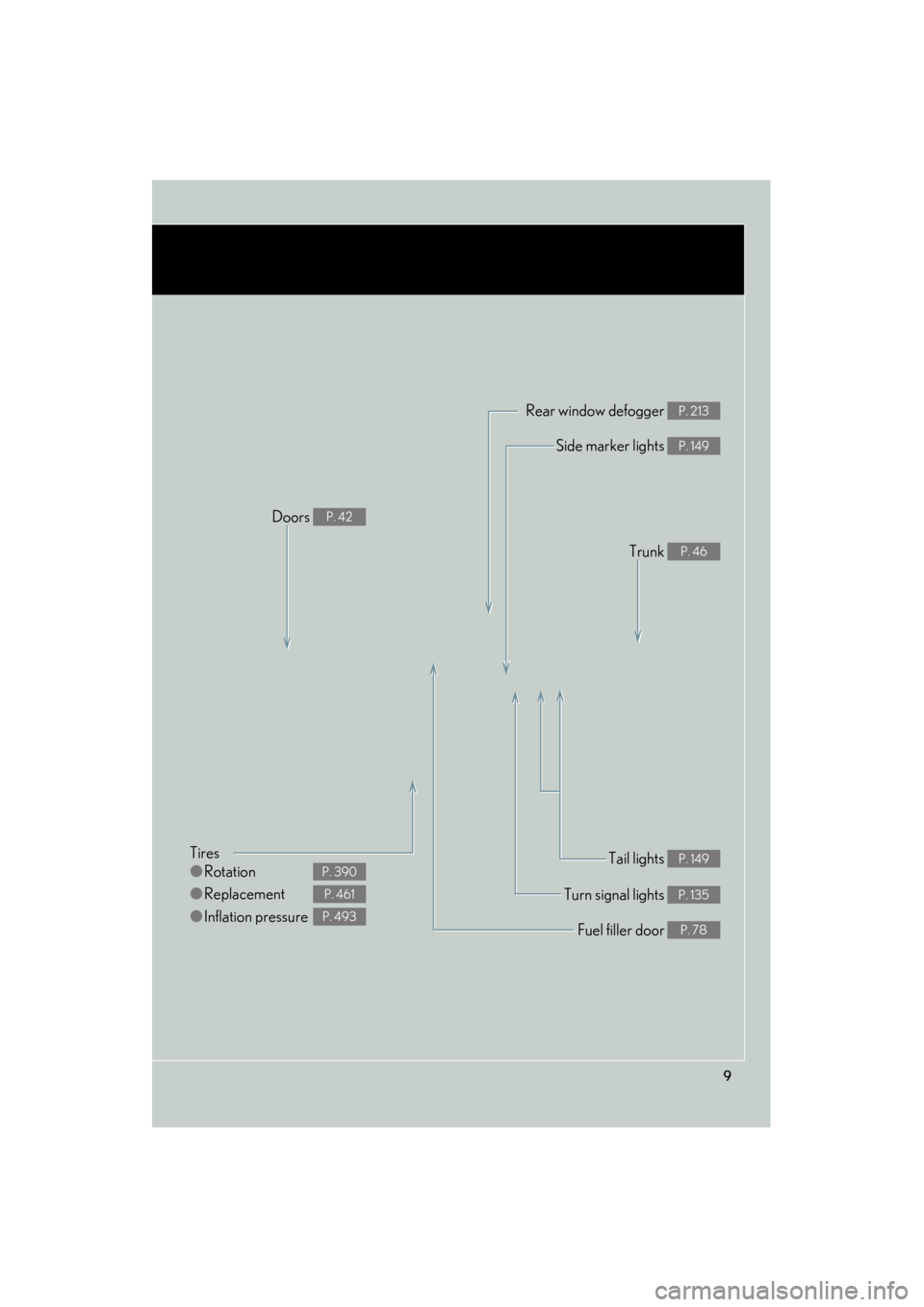
ES350_U
9
Tires
●Rotation
● Replacement
● Inflation pressure
P. 390
P. 461
P. 493
Tail lights P. 149
Side marker lights P. 149
Trunk P. 46
Rear window defogger P. 213
Doors P. 42
Fuel filler door P. 78
Turn signal lights P. 135
Page 122 of 554
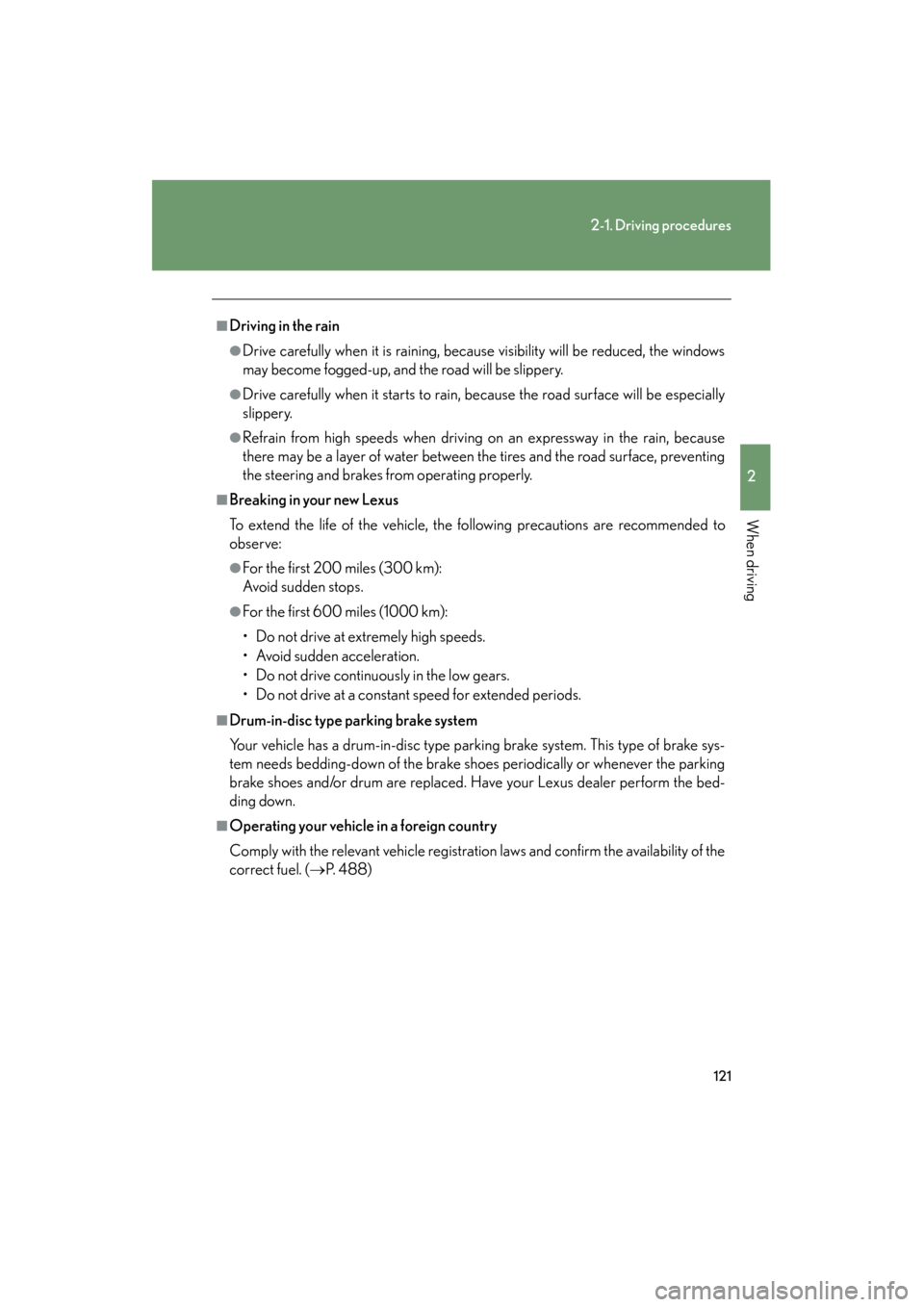
121
2-1. Driving procedures
2
When driving
ES350_U
■Driving in the rain
●Drive carefully when it is raining, because visibility will be reduced, the windows
may become fogged-up, and the road will be slippery.
●Drive carefully when it starts to rain, because the road surface will be especially
slippery.
●Refrain from high speeds when driving on an expressway in the rain, because
there may be a layer of water between the tires and the road surface, preventing
the steering and brakes from operating properly.
■Breaking in your new Lexus
To extend the life of the vehicle, the following precautions are recommended to
observe:
●For the first 200 miles (300 km):
Avoid sudden stops.
●For the first 600 miles (1000 km):
• Do not drive at extremely high speeds.
• Avoid sudden acceleration.
• Do not drive continuously in the low gears.
• Do not drive at a constant speed for extended periods.
■Drum-in-disc type parking brake system
Your vehicle has a drum-in-disc type parking brake system. This type of brake sys-
tem needs bedding-down of the brake shoes periodically or whenever the parking
brake shoes and/or drum are replaced. Have your Lexus dealer perform the bed-
ding down.
■Operating your vehicle in a foreign country
Comply with the relevant vehicle registration laws and confirm the availability of the
correct fuel. (→P. 488)
Page 124 of 554
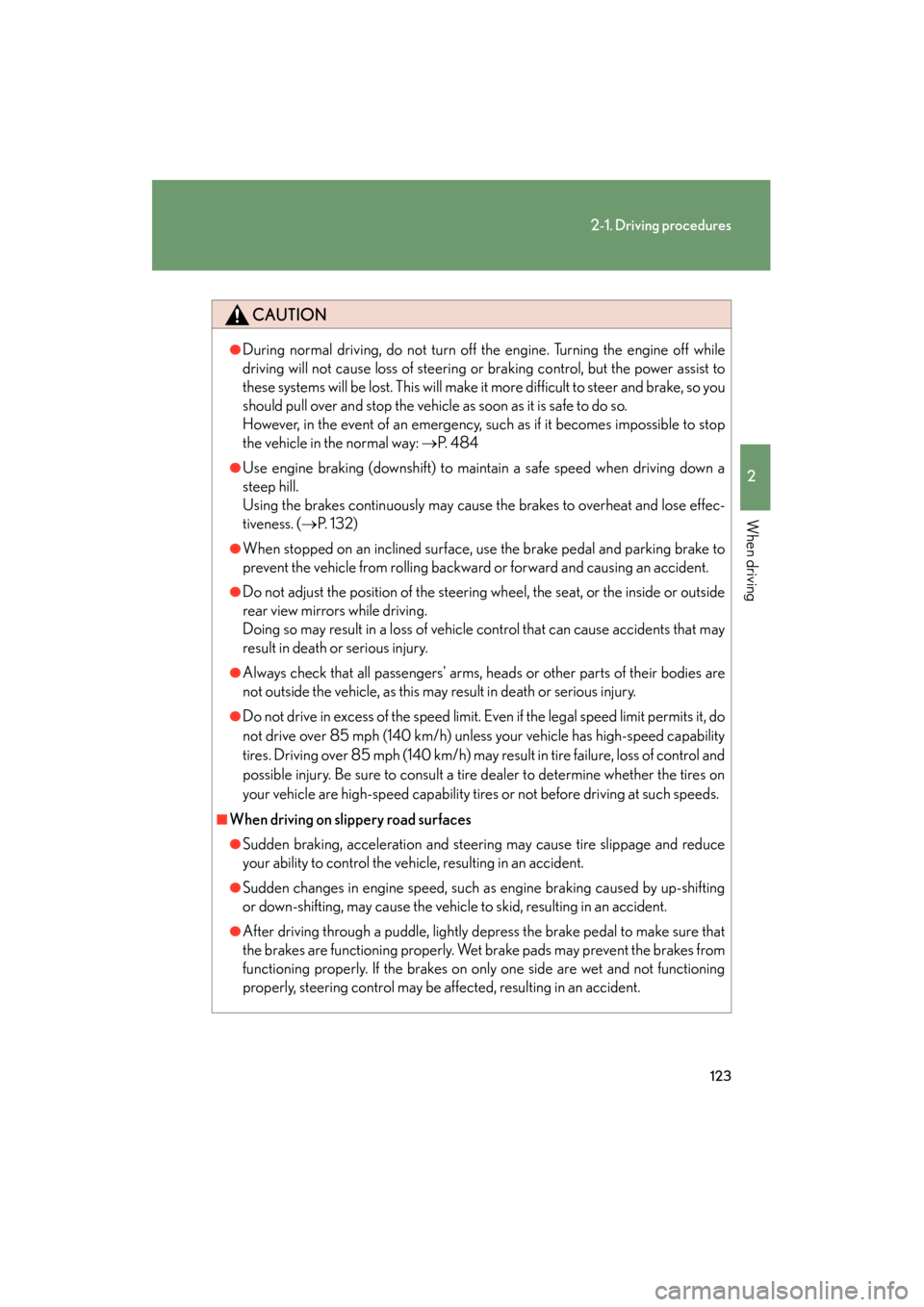
123
2-1. Driving procedures
2
When driving
ES350_U
CAUTION
●During normal driving, do not turn off the engine. Turning the engine off while
driving will not cause loss of steering or braking control, but the power assist to
these systems will be lost. This will make it more difficult to steer and brake, so you
should pull over and stop the vehicle as soon as it is safe to do so.
However, in the event of an emergency, such as if it becomes impossible to stop
the vehicle in the normal way: → P. 4 8 4
●Use engine braking (downshift) to maintain a safe speed when driving down a
steep hill.
Using the brakes continuously may cause the brakes to overheat and lose effec-
tiveness. (→P. 1 3 2 )
●When stopped on an inclined surface, use the brake pedal and parking brake to
prevent the vehicle from rolling backward or forward and causing an accident.
●Do not adjust the position of the steering wheel, the seat, or the inside or outside
rear view mirrors while driving.
Doing so may result in a loss of vehicle control that can cause accidents that may
result in death or serious injury.
●Always check that all passengers' arms, heads or other parts of their bodies are
not outside the vehicle, as this may result in death or serious injury.
●Do not drive in excess of the speed limit. Even if the legal speed limit permits it, do
not drive over 85 mph (140 km/h) unless your vehicle has high-speed capability
tires. Driving over 85 mph (140 km/h) may result in tire failure, loss of control and
possible injury. Be sure to consult a tire dealer to determine whether the tires on
your vehicle are high-speed capability tires or not before driving at such speeds.
■When driving on slippery road surfaces
●Sudden braking, acceleration and steering may cause tire slippage and reduce
your ability to control the vehicle, resulting in an accident.
●Sudden changes in engine speed, such as engine braking caused by up-shifting
or down-shifting, may cause the vehicle to skid, resulting in an accident.
●After driving through a puddle, lightly depress the brake pedal to make sure that
the brakes are functioning properly. Wet brake pads may prevent the brakes from
functioning properly. If the brakes on only one side are wet and not functioning
properly, steering control may be affected, resulting in an accident.
Page 187 of 554
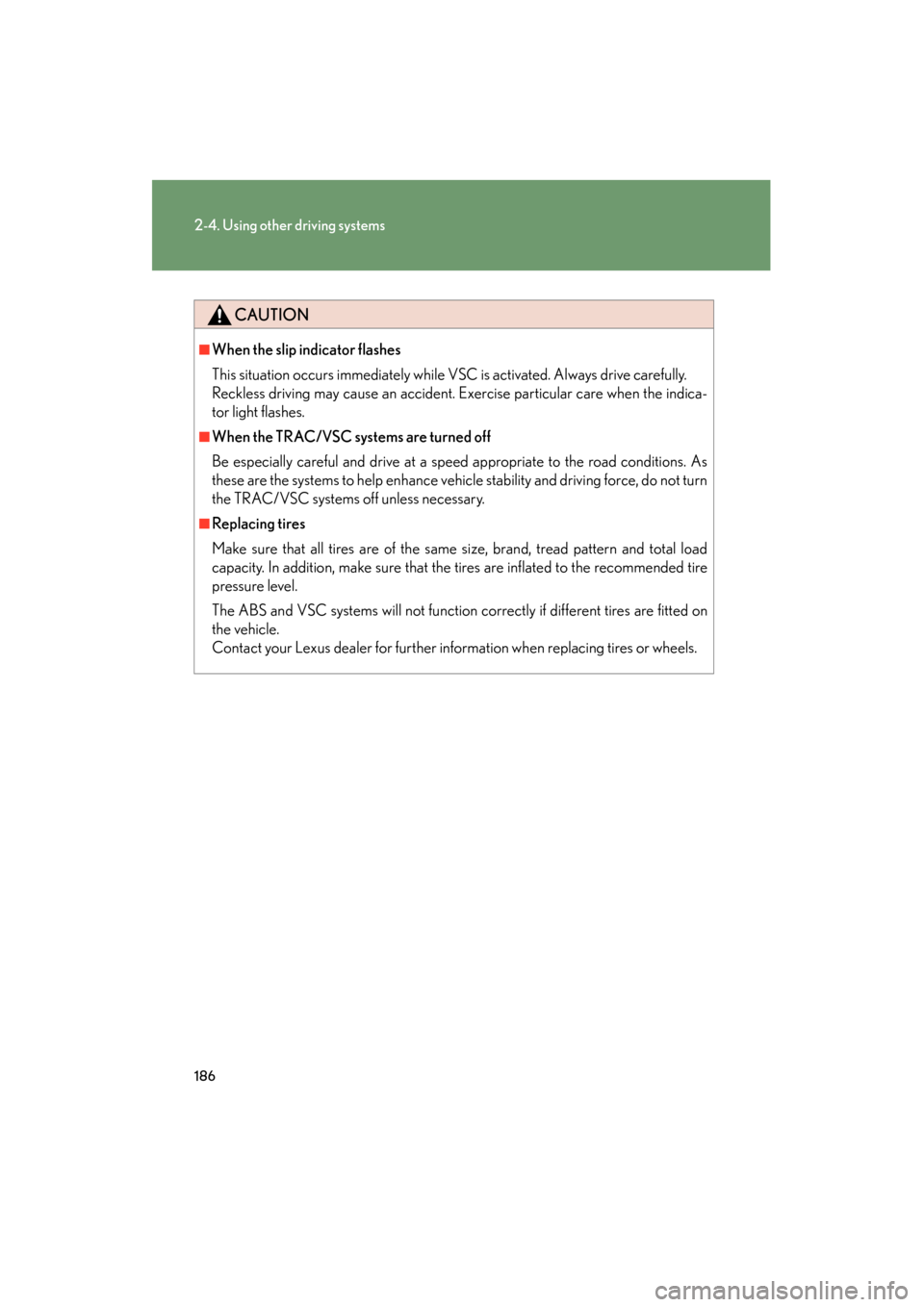
186
2-4. Using other driving systems
ES350_U
CAUTION
■When the slip indicator flashes
This situation occurs immediately while VSC is activated. Always drive carefully.
Reckless driving may cause an accident. Exercise particular care when the indica-
tor light flashes.
■When the TRAC/VSC systems are turned off
Be especially careful and drive at a speed appropriate to the road conditions. As
these are the systems to help enhance vehicle stability and driving force, do not turn
the TRAC/VSC systems off unless necessary.
■Replacing tires
Make sure that all tires are of the same size, brand, tread pattern and total load
capacity. In addition, make sure that the tires are inflated to the recommended tire
pressure level.
The ABS and VSC systems will not function correctly if different tires are fitted on
the vehicle.
Contact your Lexus dealer for further information when replacing tires or wheels.
Page 196 of 554
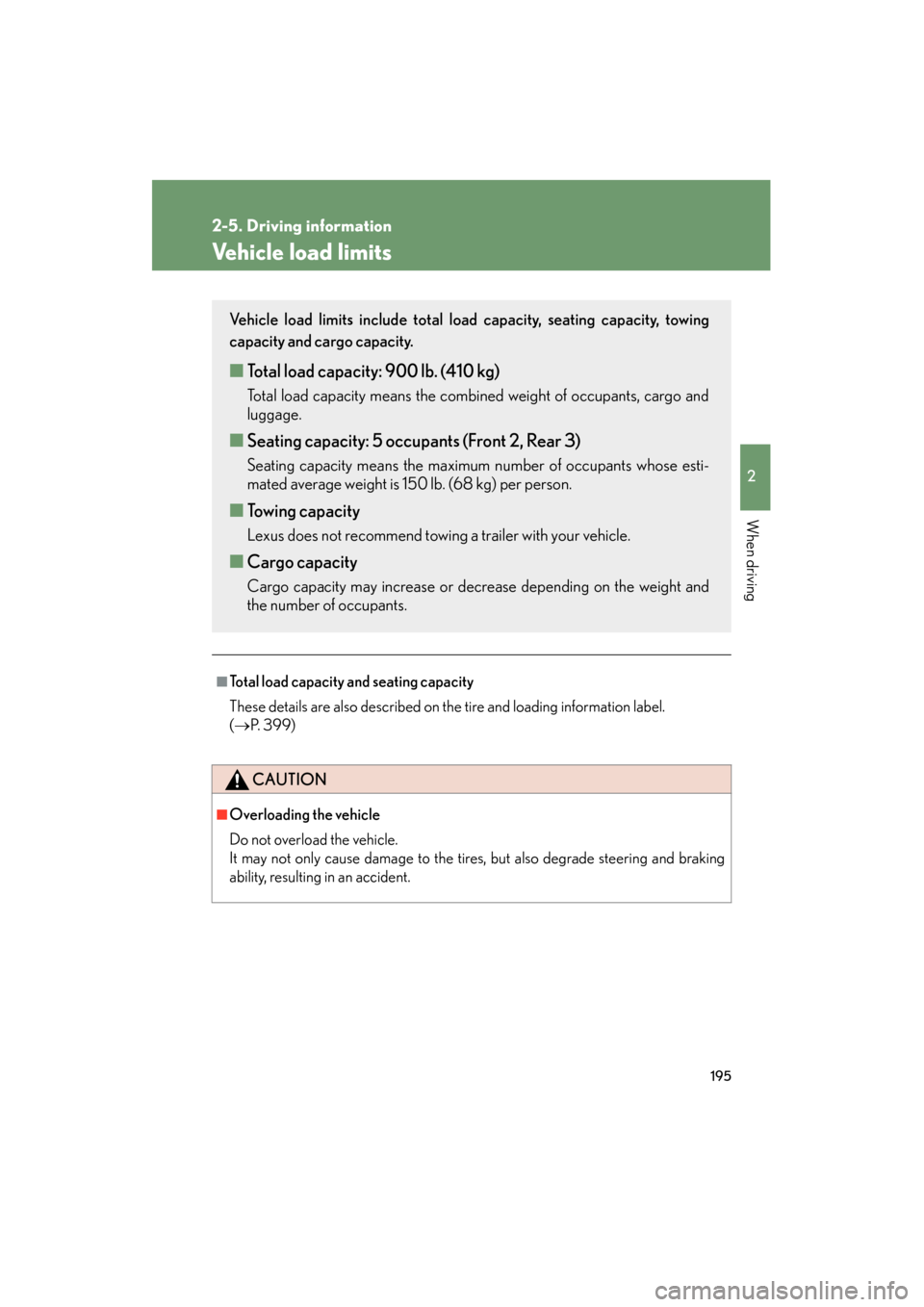
195
2-5. Driving information
2
When driving
ES350_U
Vehicle load limits
■Total load capacity and seating capacity
These details are also described on the tire and loading information label.
(→ P. 3 9 9 )
CAUTION
■Overloading the vehicle
Do not overload the vehicle.
It may not only cause damage to the tires, but also degrade steering and braking
ability, resulting in an accident.
Vehicle load limits include total load capacity, seating capacity, towing
capacity and cargo capacity.
■Total load capacity: 900 lb. (410 kg)
Total load capacity means the combined weight of occupants, cargo and
luggage.
■Seating capacity: 5 occupants (Front 2, Rear 3)
Seating capacity means the maximum number of occupants whose esti-
mated average weight is 150 lb. (68 kg) per person.
■Towing capacity
Lexus does not recommend towing a trailer with your vehicle.
■Cargo capacity
Cargo capacity may increase or decrease depending on the weight and
the number of occupants.
Page 197 of 554
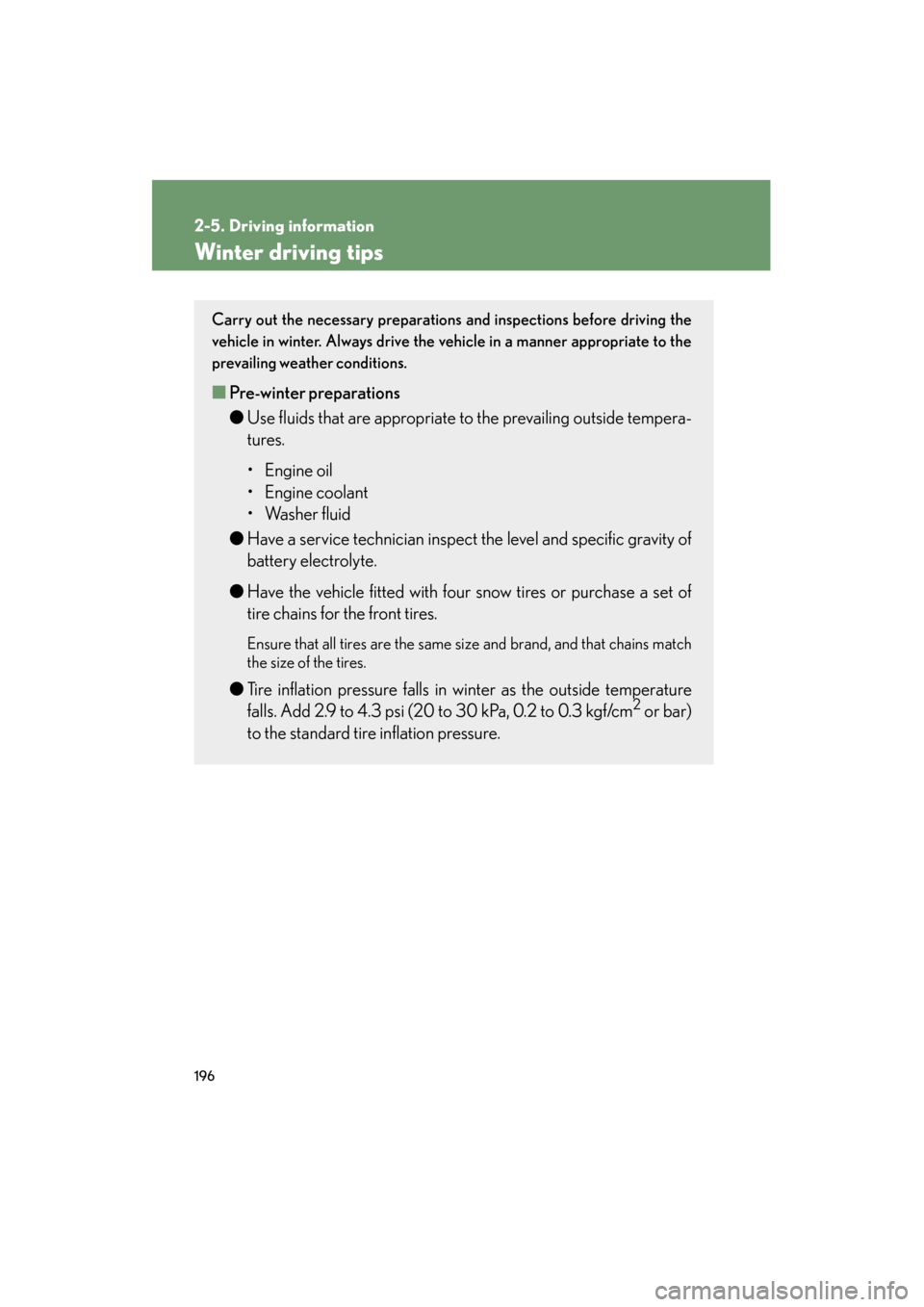
196
2-5. Driving information
ES350_U
Winter driving tips
Carry out the necessary preparations and inspections before driving the
vehicle in winter. Always drive the vehicle in a manner appropriate to the
prevailing weather conditions.
■Pre-winter preparations
● Use fluids that are appropriate to the prevailing outside tempera-
tures.
• Engine oil
• Engine coolant
• Washer fluid
● Have a service technician inspect the level and specific gravity of
battery electrolyte.
● Have the vehicle fitted with four snow tires or purchase a set of
tire chains for the front tires.
Ensure that all tires are the same size and brand, and that chains match
the size of the tires.
●Tire inflation pressure falls in winter as the outside temperature
falls. Add 2.9 to 4.3 psi (20 to 30 kPa, 0.2 to 0.3 kgf/cm2 or bar)
to the standard tire inflation pressure.
Page 199 of 554
![Lexus ES350 2012 Owners Manual 198
2-5. Driving information
ES350_U
Selecting snow chainsUse the correct snow chain size when mounting the snow chains. Chain
size is regulated for each tire sizes.
Side chain 0.12 in. [3 mm] in dia Lexus ES350 2012 Owners Manual 198
2-5. Driving information
ES350_U
Selecting snow chainsUse the correct snow chain size when mounting the snow chains. Chain
size is regulated for each tire sizes.
Side chain 0.12 in. [3 mm] in dia](/img/36/12961/w960_12961-198.png)
198
2-5. Driving information
ES350_U
Selecting snow chainsUse the correct snow chain size when mounting the snow chains. Chain
size is regulated for each tire sizes.
Side chain 0.12 in. [3 mm] in diameter
1.18 in. [30 mm] in length
0.39 in. [10 mm] in width
Cross chain
0.16 in. [4 mm] in diameter
0.98 in. [25 mm] in length
0.55 in. [14 mm] in width
Regulations on the use of snow chains
● Regulations regarding the use of tire chains vary according to location
and type of road. Always check local regulations before installing
chains.
● Install the chains on the front tires.
● Retighten the chains after driving 1 /4 - 1 /2 mile (0.5 - 1.0 km).
Page 201 of 554
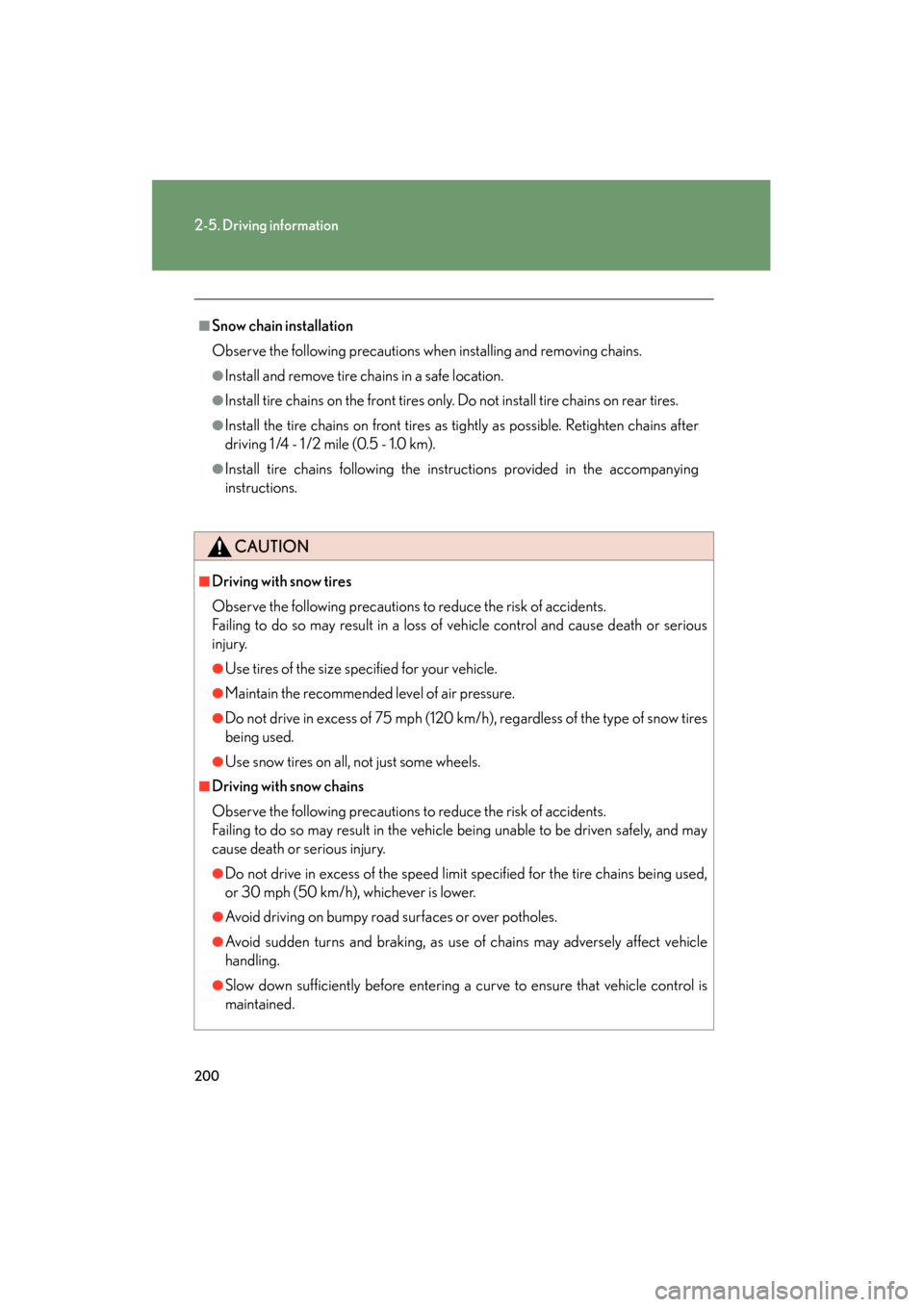
200
2-5. Driving information
ES350_U
■Snow chain installation
Observe the following precautions when installing and removing chains.
●Install and remove tire chains in a safe location.
●Install tire chains on the front tires only. Do not install tire chains on rear tires.
●Install the tire chains on front tires as tightly as possible. Retighten chains after
driving 1 /4 - 1 /2 mile (0.5 - 1.0 km).
●Install tire chains following the instructions provided in the accompanying
instructions.
CAUTION
■Driving with snow tires
Observe the following precautions to reduce the risk of accidents.
Failing to do so may result in a loss of vehicle control and cause death or serious
injury.
●Use tires of the size specified for your vehicle.
●Maintain the recommended level of air pressure.
●Do not drive in excess of 75 mph (120 km/h), regardless of the type of snow tires
being used.
●Use snow tires on all, not just some wheels.
■Driving with snow chains
Observe the following precautions to reduce the risk of accidents.
Failing to do so may result in the vehicle being unable to be driven safely, and may
cause death or serious injury.
●Do not drive in excess of the speed limit specified for the tire chains being used,
or 30 mph (50 km/h), whichever is lower.
●Avoid driving on bumpy road surfaces or over potholes.
●Avoid sudden turns and braking, as use of chains may adversely affect vehicle
handling.
●Slow down sufficiently before entering a curve to ensure that vehicle control is
maintained.
Page 202 of 554
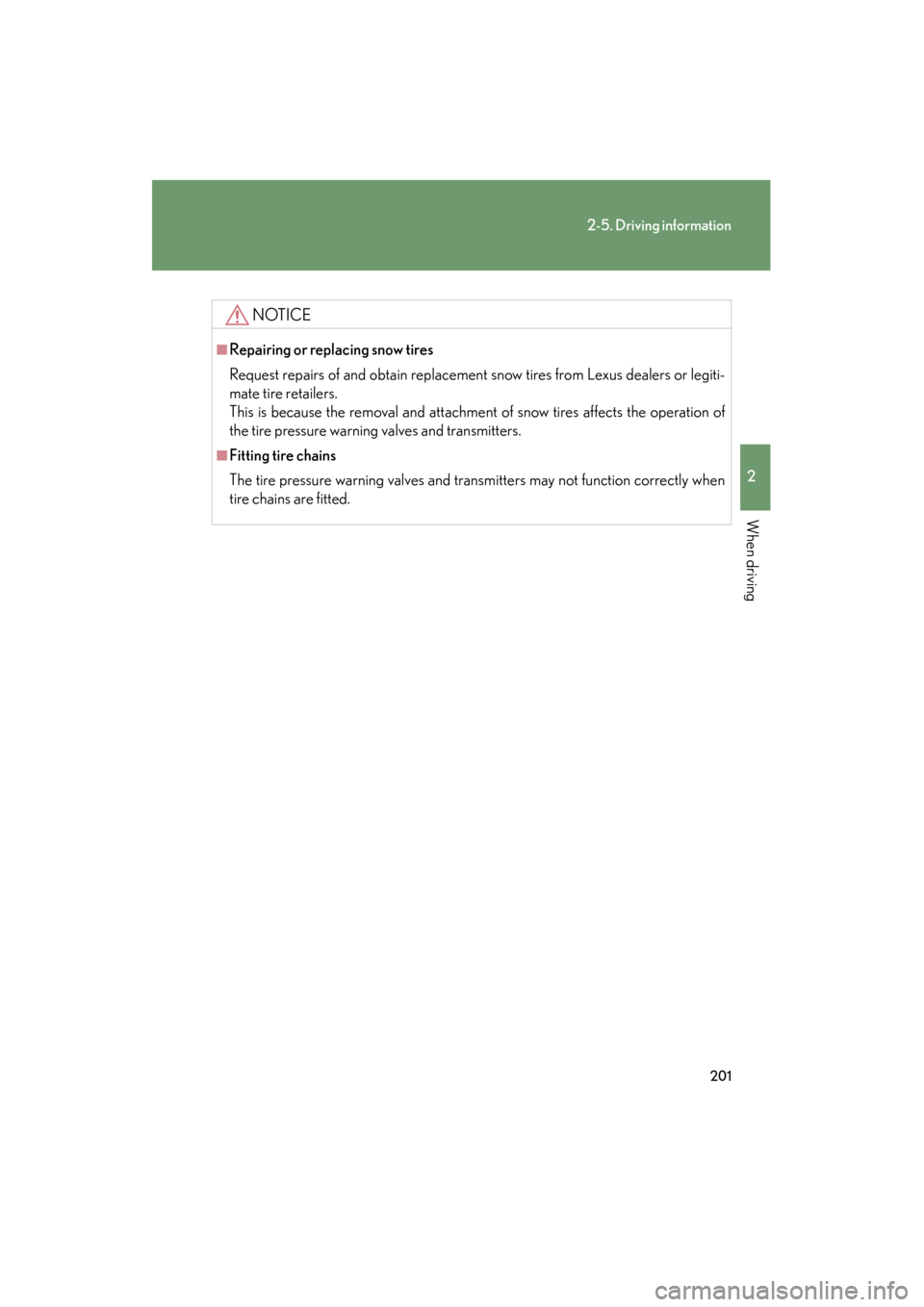
201
2-5. Driving information
2
When driving
ES350_U
NOTICE
■Repairing or replacing snow tires
Request repairs of and obtain replacement snow tires from Lexus dealers or legiti-
mate tire retailers.
This is because the removal and attachment of snow tires affects the operation of
the tire pressure warning valves and transmitters.
■Fitting tire chains
The tire pressure warning valves and transmitters may not function correctly when
tire chains are fitted.